In addition to Gravity, applied globally to Dynamics, users can also add additional 'Forces'. A Force is any influence that causes a dynamic item to undergo a change in speed or direction. Forces are global in nature and can affect both Dynamic items as well as Particle items, simultaneously, if desired. There are seven different types of Forces available to affect dynamic objects, Select one of the types to see the associated documentation related to it-
Linear Force
Forces provide a way for users to further affect and control the motion of dynamic items in a scene. The 'Force Linear' items applies a constant force globally to all dynamic items in the direction determined by the Force's Rotational X, Y, or Z values. Linear Force can be thought as being similar to wind, but without the 'Speed' dynamic that wind has. The higher the 'Strength' value, the stronger the force applied to the dynamic objects.
Users can add a 'Linear Force' item to a simulation by selecting the "Forces > Linear" option in the Dynamics subtab of the Layout interfaces toolbox. Additionally, users may also use Item Lists 'Add Item' button under "Forces > Linear Force". Any Forces added after a Dynamic Body will auto-connect to the Solver item, Forces added before hand will need to be connected manually in the Schematic view. Removing Force items is done the same way as any other item by simply selecting the item and pressing the 'Delete' key on the keyboard. When selected, the following attribute appear in the Properties viewport-
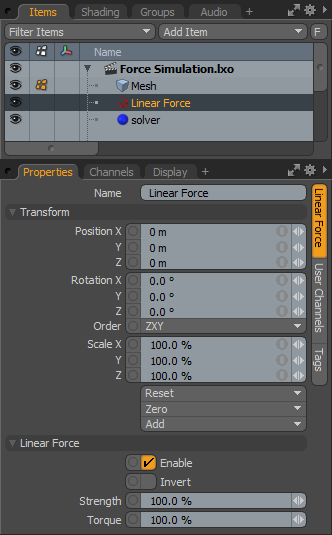 Name: This data field displays the current Force items name. Users may easily change it by LMB-clicking within the field and typing the new name.
Name: This data field displays the current Force items name. Users may easily change it by LMB-clicking within the field and typing the new name.
Transform--
Position X/Y/Z: The Force Linear item globally affects dynamic items regardless of its position, therefore the Position X, Y & Z values in this case are superfluous and have no bearing on the forces affect.
Rotation X/Y/Z: Rotation Values affect the direction of the linear force options allowing users to easily change the direction of the force applied to dynamic items. Default forward direction is Y+.
Scale X/Y/Z: The Force Linear item globally affects dynamic items regardless of its scale, therefore the Scale X, Y & Z values in this case are superfluous. To adjust the strength of the Linear Force, adjust the 'Strength' value.
Linear Force--
Enable: The 'Enable' option toggles the Force item on or off. When enabled the force item will be considered during a dynamics simulation, when disabled, the force item will be ignored. However, disabled forces are persistent across MODO sessions being saved with the scene, and retain their present settings.
Invert: Reverses the direction of the Linear Force.
Strength: The 'Strength' value that acts as a multiplier on an objects motion in the direction the force is oriented toward. The higher the value the greater the strength of the force.
Torque: The 'Torque' value act as a multiplier on rotational movements of Dynamic items. The higher the value the greater the strength of the force.
Radial Force
Forces provide a way for users to further affect and control dynamic items in a scene. The 'Force Radial' items applies a force that draws items toward or pushes then away from the force Locator center (defined by the items position).
This force can be thought of like a magnet that repels or attracts dynamic objects. The higher the positive value, the stronger the push force applied, the greater the negative value, the stronger the attraction.
Users can add a 'Radial Force' item to a simulation by selecting the "Forces >Radial" option in the Dynamics subtab of the Layout interfaces toolbox. Additionally, users may also use Item Lists 'Add Item' button under "Forces > Radial Force". Any Forces added after a Dynamic Body will auto-connect to the Solver item, Forces added before hand will need to be connected manually in the Schematic view. Removing Force items is done the same way as any other item by simply selecting the item and pressing the 'Delete' key on the keyboard. When selected, the following attribute appear in the Properties viewport-
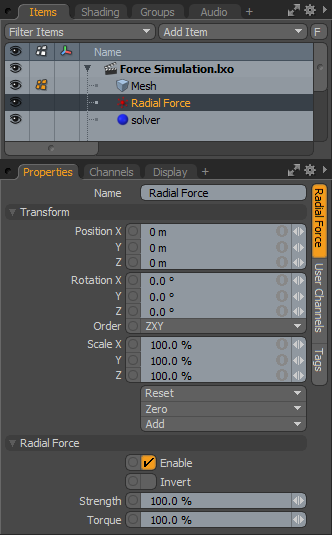 Name: This data field displays the current Force items name. Users may easily change it by LMB-clicking within the field and typing the new name.
Name: This data field displays the current Force items name. Users may easily change it by LMB-clicking within the field and typing the new name.
Transform--
Position X/Y/Z: An Item transform that allows the user to numerically position the Force item in XYZ space, representing the point of the repulsion or attraction.
Rotation X/Y/Z: The Force Radial item effects items radially, therefore the Rotation X, Y & Z values are superfluous.
Scale X/Y/Z: The Force Radial item globally affects dynamic items regardless of its scale, therefore the Scale X, Y & Z values in this case are superfluous.
Radial Force--
Enable: The 'Enable' option toggles the Force item on or off. When enabled the force item will be considered during a dynamics simulation, when disabled, the force item will be ignored. However, disabled forces are persistent across MODO sessions being saved with the scene, and retain their present settings.
Invert: Reverses the pull direction of the Radial Force.
Strength: The 'Strength' value determines how powerful the force is pulling or repelling. The higher the value, the greater the influence of the force. Negative values will push dynamic items away, and positive ones will pull them toward the Radial Force.
Torque: The 'Torque' value act as a multiplier on rotational movements of Dynamic items. The higher the value the greater the strength of the force.
Drag Force
Forces provide a way for users to further affect and control dynamic items in a scene. The 'Force Drag' items applies a counter force to the objects current linear and rotational velocities. This is useful in slowing object motions, kind of like dragging it through molasses. The higher the value, the stronger the drag applied to the dynamic objects.
Users can add a 'Drag Force' item to a simulation by selecting the "Forces >Drag" option in the Dynamics subtab of the Layout interfaces toolbox. Additionally, users may also use Item Lists 'Add Item' button under "Forces > Drag Force". Any Forces added after a Dynamic Body will auto-connect to the Solver item, Forces added before hand will need to be connected manually in the Schematic view. Removing Force items is done the same way as any other item by simply selecting the item and pressing the 'Delete' key on the keyboard. When selected, the following attribute appear in the Properties viewport-
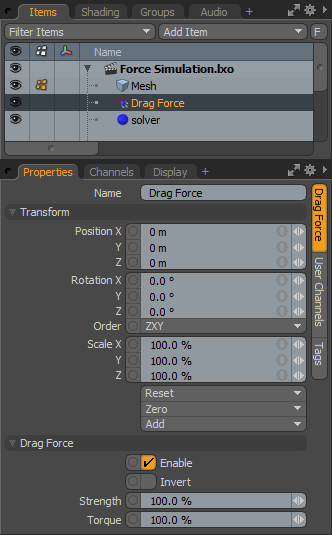 Name: This data field displays the current Force items name. Users may easily change it by LMB-clicking within the field and typing the new name.
Name: This data field displays the current Force items name. Users may easily change it by LMB-clicking within the field and typing the new name.
Transform--
Position X/Y/Z: Defines the Locator position for the Drag Force item. By default, the Force Drag item affects dynamic objects globally, so position of the item in the scene is irrelevant to its affect.
Rotation X/Y/Z: The Force Drag item globally affects dynamic items regardless of its rotation, therefore the Rotation X, Y & Z values in this case are superfluous.
Scale X/Y/Z: The Force Drag item globally affects dynamic items regardless of its scale, therefore the Scale X, Y & Z values in this case are superfluous. To adjust the amount of force attenuation, modify the 'Strength' value.
Drag Force--
Enable: The 'Enable' option toggles the Force item on or off. When enabled the force item will be considered during a dynamics simulation, when disabled, the force item will be ignored. However, disabled forces are persistent across MODO sessions being saved with the scene, and retain their present settings.
Invert: Reverses the Drag effect on dynamic items.
Strength: The 'Strength' value that acts as a multiplier on an objects motion. The higher the value the greater the strength of the Drag. Positive values will slow dynamic items down, and negative ones will impel them to move faster.
Torque: The 'Torque' value act as a multiplier on rotational movements of Dynamic items. The higher the value the greater the strength of the drag.
Turbulence Force
Forces provide a way for users to further affect and control dynamic items in a scene. The 'Force Turbulence' item applies a noise like function to a dynamic items movements producing an unsteady or agitated motion. Useful in adding a small or large amount of randomness to simulations, depending of the strength of the affect. The higher the value, the stronger the Turbulence applied to the dynamic objects.
Users can add a 'Turbulence Force' item to a simulation by selecting the "Forces > Turbulence" option in the Dynamics subtab of the Layout interfaces toolbox. Additionally, users may also use Item Lists 'Add Item' button under "Forces > Turbulence Force". Any Forces added after a Dynamic Body will auto-connect to the Solver item, Forces added before hand will need to be connected manually in the Schematic view. Removing Force items is done the same way as any other item by simply selecting the item and pressing the 'Delete' key on the keyboard. When selected, the following attribute appear in the Properties viewport-
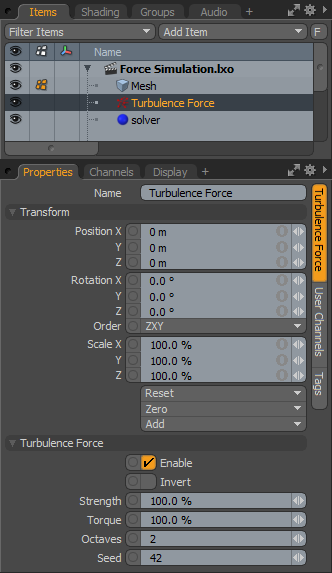 Name: This data field displays the current Force items name. Users may easily change it by LMB-clicking within the field and typing the new name.
Name: This data field displays the current Force items name. Users may easily change it by LMB-clicking within the field and typing the new name.
Transform--
Position X/Y/Z: The position can modify the way in which the Turbulence affects dynamic objects, as changing the positions changes the location of the turbulence field.
Rotation X/Y/Z: Determines the rotation of the Turbulence field as X,Y & Z values for each axis.
Scale X/Y/Z: Defines the scale of the turbulence field as X,Y & Z values for each axis.
Turbulence Force--
Enable: The 'Enable' option toggles the Force item on or off. When enabled the force item will be considered during a dynamics simulation, when disabled, the force item will be ignored. However, disabled forces are persistent across MODO sessions being saved with the scene, and retain their present settings.
Invert: Reverses the turbulence influence field on Dynamic Items.
Strength: The 'Strength' value determines how much influence the Turbulence field has on the dynamic items. The higher the value the greater the disturbing strength of the Turbulence.
Torque: The 'Torque' value act as a multiplier on rotational movements of Dynamic items. The higher the value the greater the influence of the Turbulence.
Octaves: The 'Octaves' value determines the number of layers for the noise function, where each additional layer adds complexity to the field, subsequently making finer details to the turbulent motion applied.
Seed: The 'Seed' attribute defines the initial value for the noise function, with every different value producing a different random variation to the noise. If a Turbulence field isn't producing the results you like, users can try adjusting this value to sample different randomized fields.
Vortex Force
Forces provide a way for users to further affect and control dynamic items in a scene. The 'Force Vortex' items applies a rotational swirling force, like a whirlpool, spinning dynamic items around the force locator's center (defined by the items center position).
Users can add a 'Vortex Force' item to a simulation by selecting the "Forces > Vortex" option in the Dynamics subtab of the Layout interfaces toolbox. Additionally, users may also use Item Lists 'Add Item' button under "Forces > Vortex Force". Any Forces added after a Dynamic Body will auto-connect to the Solver item, Forces added before hand will need to be connected manually in the Schematic view. Removing Force items is done the same way as any other item by simply selecting the item and pressing the 'Delete' key on the keyboard. When selected, the following attribute appear in the Properties viewport-
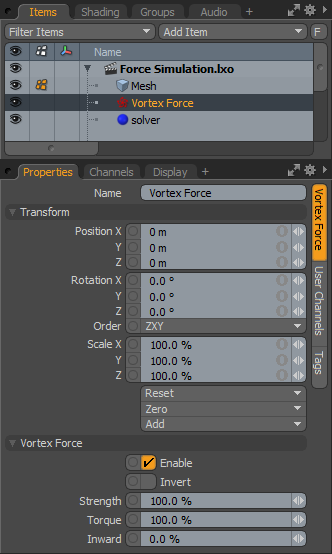 Name: This data field displays the current Force items name. Users may easily change it by LMB-clicking within the field and typing the new name.
Name: This data field displays the current Force items name. Users may easily change it by LMB-clicking within the field and typing the new name.
Transform--
Position X/Y/Z: The 'Position' XY & Z values determine the vortex line - the center position for the vortex force, where all items affected by the vortex spin around this central point.
Rotation X/Y/Z: The rotational values can determine the angle that the vortex revolves around, defined by the X, Y & Z rotation values.
Scale X/Y/Z: The Force Vortex item globally affects dynamic items regardless of its scale, therefore the Scale X, Y & Z values in this case are superfluous. To adjust the influence of the force, modify the 'Strength' value.
Vortex Force--
Enable: The 'Enable' option toggles the Force item on or off. When enabled the force item will be considered during a dynamics simulation, when disabled, the force item will be ignored. However, disabled forces are persistent across MODO sessions being saved with the scene, and retain their present settings.
Invert: Reverses the affect of the Vortex on Dynamic items, altering its draw and rotation direction.
Strength: The 'Strength' value determines how much influence the Vortex has on the dynamic items. The higher the value the greater the rotational influence of the vortex.
Torque: The 'Torque' value act as a multiplier on rotational movements of Dynamic items. The higher the value the greater the influence of the Vortex on rotations.
Inward: Controls the inward pull toward the center of the Vortex. As items spin around the central point, when the speed increases the resulting centrifugal force impels dynamic bodies outward, the 'Inward' option is a means to oppose that force.
Wind Force
Forces provide a way for users to further affect and control dynamic items in a scene. The 'Wind Force' will directionally accelerate or decelerate the speed of dynamic items in a scene until the velocities match that of the Wind Force.
Users can add a 'Wind Force' item to a simulation by selecting the "Forces > Wind" option in the Dynamics subtab of the Layout interfaces toolbox. Additionally, users may also use Item Lists 'Add Item' button under "Forces > Wind Force". Any Forces added after a Dynamic Body will auto-connect to the Solver item, Forces added before hand will need to be connected manually in the Schematic view. Removing Force items is done the same way as any other item by simply selecting the item and pressing the 'Delete' key on the keyboard. When selected, the following attribute appear in the Properties viewport-
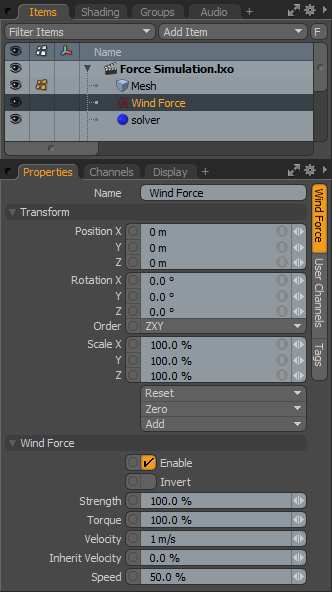 Name: This data field displays the current Force items name. Users may easily change it by LMB-clicking within the field and typing the new name.
Name: This data field displays the current Force items name. Users may easily change it by LMB-clicking within the field and typing the new name.
Transform--
Position X/Y/Z: The Force Wind item globally affects dynamic items regardless of its position, therefore the Position X, Y & Z values in this case are superfluous and have no bearing on the forces affect.
Rotation X/Y/Z: Rotation Values affect the direction of the wind force options allowing users to easily change the direction of the force applied to dynamic items. Default forward direction is Y+.
Scale X/Y/Z: The Force Wind item globally affects dynamic items regardless of its scale, therefore the Scale X, Y & Z values in this case are superfluous.
Wind Force--
Enable: The 'Enable' option toggles the Force item on or off. When enabled the force item will be considered during a dynamics simulation, when disabled, the force item will be ignored. However, disabled forces are persistent across MODO sessions being saved with the scene, and retain their present settings.
Invert: When enabled will reverse the directional values of the Wind.
Strength: The 'Strength' value determines how much influence the Wind force has on the dynamic items. The higher the value the greater the push of the wind.
Torque: The 'Torque' value determines how much influence the Wind force has on the dynamic items. The higher the value the greater the push of the wind.
Velocity: The 'Velocity' is the speed that the wind force is moving. Dynamic items affected by this force will not move faster than the defined value (unless of course they have their own additional Forces or Impulses controlling them).
Inherit Velocity: The 'Inherit Velocity' option controls to what degree the motions of the Wind Force Locator itself affects the Wind movement.
Speed: The 'Speed' option determines the actual speed at which the Force moves or affects its target items.
Curve Force
Forces provide a way for users to further affect and control dynamic items in a scene. The 'Curve Force' will allow users to use a drawn curve to determine the directional flow of dynamic items, flowing from the curves base, the first point, toward its end point. The Curve Force would be useful in cases such as getting particles to flow through a bent hollow tube or along a meandering stream.
The Curve Force, of course, requires a curve to apply the force with, so users will first need a drawn curve of some type, either a Hermite Curve or a Bezier curve will work. It is a good practice to keep curves isolated withing their own mesh layer. With the curve created, users can add a 'Curve Force' item to a simulation by selecting the "Forces > Curve" option in the Dynamics subtab of the Layout interfaces toolbox. Additionally, users may also use the Item Lists 'Add Item' button under "Forces > Curve Force". Once created, it is necessary to connect the items manually within the Schematic viewport. The Mesh Item containing the curves(s) will need to be connected to the mesh input of the 'Curve Force' item like this-

Removing Force items is done the same way as any other item by simply selecting the item and pressing the 'Delete' key on the keyboard. When selected, the following attribute appear in the Properties viewport-
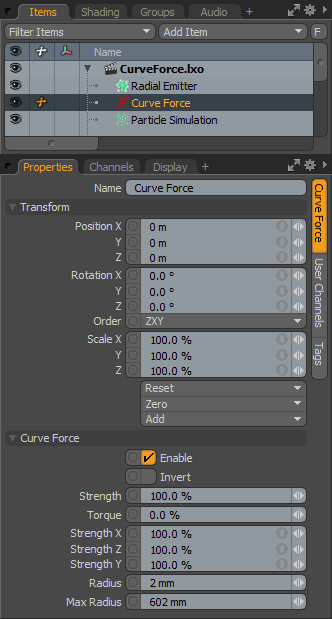 Name: This data field displays the current Force items name. Users may easily change it by LMB-clicking within the field and typing the new name.
Name: This data field displays the current Force items name. Users may easily change it by LMB-clicking within the field and typing the new name.
Transform--
Position X/Y/Z: The Curve Force item affects dynamic items based on the position of an external curve item, therefore the Position X, Y & Z values in this case are superfluous and have no bearing on the forces affect.
Rotation X/Y/Z: The Curve Force item affects dynamic items based on the position of an external curve item, therefore the Rotation X, Y & Z values in this case are superfluous.
Scale X/Y/Z: The Curve Force item affects dynamic items based on the position of an external curve item, therefore the Scale X, Y & Z values in this case are superfluous.
Curve Force--
Enable: The 'Enable' option toggles the Force item on or off. When enabled the force item will be considered during a dynamics simulation, when disabled, the force item will be ignored. However, disabled forces are persistent across MODO sessions being saved with the scene, and retain their present settings.
Invert: Reverses the direction of the Curve Force where the force will flow from the end toward the base.
Strength: The 'Strength' value determines how much influence the Curve Force has on the dynamic items. The higher the value the greater the influence of the Curve Force.
Torque: The 'Torque' value act as a multiplier on rotational movements of Dynamic items. The higher the value the greater the influence of the Vortex on rotations.
Strength X/Y/Z: Acts as a multiplier over individual directional vectors as dynamic items move along the curve.
Radius: The 'Radius' value determines the area or volume around the curve where dynamic items will try to remained constrained within unless affected by other stronger forces..
Max Radius: The 'Max Radius' value determines the maximum area around the curve where the force will try to attract dynamic items. Anything outside this area is ignored.
Top
 Name: This data field displays the current Force items name. Users may easily change it by LMB-clicking within the field and typing the new name.
Name: This data field displays the current Force items name. Users may easily change it by LMB-clicking within the field and typing the new name.


 Name: This data field displays the current Force items name. Users may easily change it by LMB-clicking within the field and typing the new name.
Name: This data field displays the current Force items name. Users may easily change it by LMB-clicking within the field and typing the new name. Name: This data field displays the current Force items name. Users may easily change it by LMB-clicking within the field and typing the new name.
Name: This data field displays the current Force items name. Users may easily change it by LMB-clicking within the field and typing the new name. Name: This data field displays the current Force items name. Users may easily change it by LMB-clicking within the field and typing the new name.
Name: This data field displays the current Force items name. Users may easily change it by LMB-clicking within the field and typing the new name. Name: This data field displays the current Force items name. Users may easily change it by LMB-clicking within the field and typing the new name.
Name: This data field displays the current Force items name. Users may easily change it by LMB-clicking within the field and typing the new name. Name: This data field displays the current Force items name. Users may easily change it by LMB-clicking within the field and typing the new name.
Name: This data field displays the current Force items name. Users may easily change it by LMB-clicking within the field and typing the new name.
 Name: This data field displays the current Force items name. Users may easily change it by LMB-clicking within the field and typing the new name.
Name: This data field displays the current Force items name. Users may easily change it by LMB-clicking within the field and typing the new name.